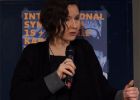Reversing the vectors of meaning. The diagrammatic language of Vilém Flusser
According to his own cultural analysis, Flusser was a man of yesterday. He, who wrote nearly every day of his life, was himself subject to the “textolatry” of modernity. A modernity, though, which would soon shift into a new epoch which Flusser and others had given similar names: post-histoire, post- modernity, information or telematic society. In this new situation, according to Flusser, written text would become a marginal code, soon to be superseded by the “technical image” as universal means of communication and information storage. Thus, Flusser described authors like himself, which would stay engaged with text, as “the new illiterates” of the upcoming age. But although Flusser was a man of the written word, I will argue that there was at least one type of sign system with which he also operated frequently and which can be linked to his image heuristics: the diagram. Scattered over his manuscripts, letters and notes, over 160 diagrammatic sketches can be found in the Vilém Flusser Archive. Compared to the thousands of documents in the archive, this seems to be a small number. But his diagrammatic sketches are not only interesting considering the nearly exclusively textual character of Flusser’s legacy; they can also be described as Flusserian technical images. According to the semiotic definition of the diagram by Charles S. Peirce, diagrammatic signs constitute a specific subclass of the icon: A diagram resembles its object not by visual but structural similarity. By drawing a diagram, one proposes a hypothesis about the structure of its object, thus manifesting an abstract concept as a concrete sign. Here we come close to Flusser’s notion of technical images as projections of abstract models. Following up on this comparison, the paper pleas for a non-trivial relation between Flusser’s heuristic of the technical image and his diagrammatic practice.
From Hegel to Zielinski: An Essay on German Media Philosophy
This article discusses an original media philosophy emerging in the German-language since the 1980s. Its relevant contexts described here include phenomenology, social critical theory (the Frankfurt School), and deconstructionism. The starting point of this paper is Hegel’s romantic vision of culture as language, and the area of meanings conveyed by speech and writing, whereas the conclusion is the vision of culture permeated by digital technologies. The so-called “medial turn” is a new opening for philosophical reflection under the aegis of Medienphilosophie. The presentation of its conceptual framework and analytical style is addressed here by the methodological and philosophical devices of Siegfried Zielinski’s media archeology.
Can We Think Computation in Images or Numbers? Critical Remarks on Vilém Flusser’s Philosophy of Digital Technologies
The article questions Flusser’s concept of the computational universe based on technical images. Emphasizing the role of the calculative, formal consciousness the article suggests a non-representational, non-hermeneutical approach to “calculating machines” as machines that allow to mechanize a certain type of thinking (mathematical thinking). At the same time, the article reformulates Flusser’s search for a new philosophy as a critical intervention into the programmed universe, arguing that this philosophy must not follow its technical logic, but find a way to reflect how different techniques and practices shape the numerical, imaginative and textual consciousness.
Vilém Flussers Bild-Theorie. Zur Philosophie des technischen Bildes ausgehend von der Fotografie
Towards a Philosophy of Photography presents all aspects of Flusser’s theory of technical images as well as the images’ ambivalence and paradoxes: the relation of writing and image from a historical and a post-historical perspective, the definition of technical images as images of concepts and as products of the (here: photographic) apparatus. The starting point of this approach to the photographic image is meta-theoretical: Flusser’s philosophical method oscillates between ‘telling stories’, a philosophical argumentation in the tradition of phenomenology, language philosophy and structuralism, a specific use of metaphors – and often together with Flusser’s own reflections of his ‘stories’, of ‘method’ and ‘metaphors’. This article explores Flusser’s philosophy as a field of intertwined ‘layers’ of argumentation that overlap in Flusser’s search for a new philosophy, corresponding with the new kind of images he proposes: a new philosophy in or through images. From this perspective, the shift from writing to image is accomplished by a shift from meta-theory to a ‘dia’ philosophy (Dieter Mersch), referring to the ‘metaphorological’ dimension of Flusser’s texts and his ‘gestures’.
Bilder – Denken. Über die Notwendigkeit einer Philosophie der Fotografie
In this contribution Claudia Becker examines the necessity for a “Philosophy of Photography” Flusser proposed in the 1980s. She expounds the problem that there is no deeper reception of his thought in the various discourses of the pictorial turn or media philosophy, even though Flusser can be read as one of the first who proclaimed a philosophy of (technical) images. She takes a closer look at the propositions of what Flusser calls a philosophy of photography and correlates them with other famous thinkers and philosophers.

